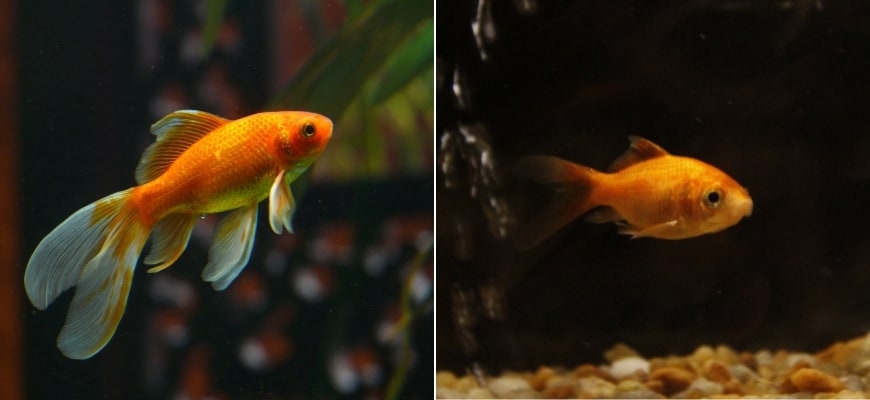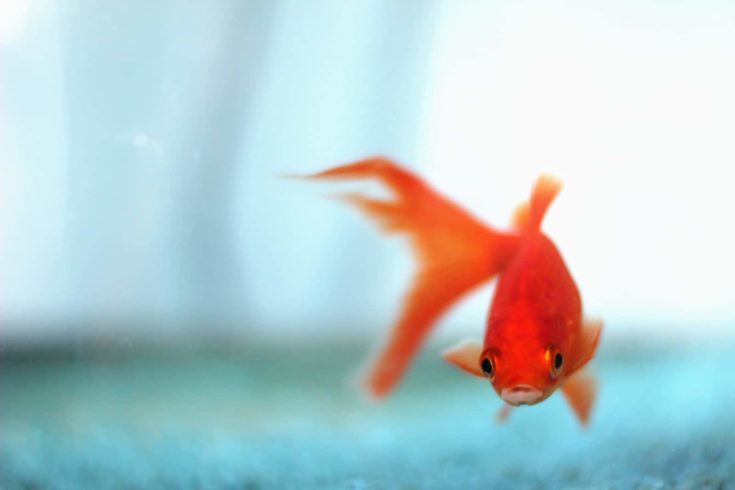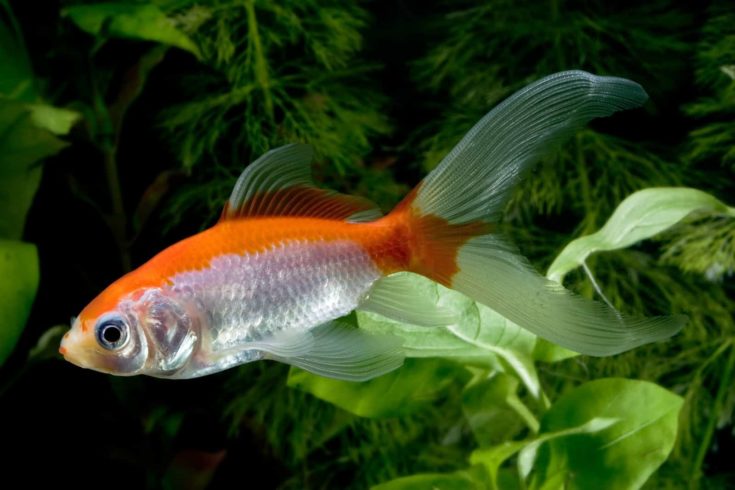One of the most famous members of the carp family, goldfish have become extremely popular around the world for their distinctive colors and flashy personalities. These fish come in dozens of varieties which means that there’s something for every hobbyist.
Two of the most common types of goldfish are comet goldfish and the common goldfish. These are both incredibly hardy, resilient fish, which makes them a hit with fishkeepers of all experience levels. Read on to learn how to tell them apart!
What’s The Difference Between Comet vs. Common Goldfish?

The biggest difference between a comet and a common goldfish lies in the fins. Comet goldfish got their name from their fins, which are long, flowy, and appear to drift across the water. Meanwhile, common goldfish have short, stiff, and pointed fins that resemble small triangles.
Another telling difference is that the common goldfish is approximately 50% larger than the comet goldfish. The common goldfish can grow up to 18 inches long, while the comet goldfish hits its maximum growth at about 12 inches or 1 foot long.
Comparison Of Common Goldfish vs. Comet Goldfish
At first glance, the common and comet goldfish appear similar – they come in the same colors and can appear to be identically sized if they’ve yet to maximize their growth capacity. They are also fish that are relatively slim and possess only one anal fin.
Though it may be hard to spot the difference between the two, a closer look reveals several ways to do so. Here’s a quick overview of the traits that belong to common vs. comet goldfish!
Common Goldfish

Fins
Stiff fins appear relatively short compared to the rest of their bodies.
Tail
Tails that appear subtly forked and have a shorter length
Size
Up to 18 inches
Body Color
Iridescent shades of orange, yellow, gold, red, or pearly white. Also includes more unique colors such as bluish-grey, brown, and black.
Body shape
Elongated, flattened, and oval-shaped body
Comet Goldfish

Fins
Flowy fins that are sometimes as long as their bodies.
Tail
Long, flowy, deeply forked tail fins that are almost the length of the fish’s body
Size
Up to 12 inches
Body Color
Reddish-orange, yellow, white, red, or a bicolor combination of red and white.
Body shape
Shorter, rounder, leaner body shape compared to the common goldfish.
Common Goldfish
The common goldfish is a domesticated variant of their living ancestor, the Prussian Carp. This means that they belong to the carp family and thrive under many of the same conditions favored by fish in the same family. Let’s take a closer look at some of these factors.
Habitat
The prevailing stereotypes would have you believe that the common goldfish enjoy spending their days in tiny bowls. This could not be further from the truth. Just because these hardy fish are capable of surviving in subpar conditions, doesn’t mean that they can do so for an extended period.
Pro Tip
To raise truly healthy goldfish, you need to house them in tanks that contain at least 55 gallons of water. These are fish that can grow up to 18 inches long and should be given the space necessary to do so.
If you intend to house your goldfish in an outdoor pond, even better. When housed in an outdoor setup that closely resembles their natural habitat, goldfish have been known to live for up to 20 years!
Body Shape
As previously mentioned, The common goldfish is a descendant of the Prussian carp. This means that their body shape is similar to that of their living ancestors. Common goldfish have oval-shaped, flattened, elongated bodies that resemble a football. Compared to the comet goldfish, their bodies are slightly larger and rounder.
Common goldfish also have short, triangular fins. Because of their length, they appear short and stiff. This is the key difference between common and comet goldfish.
Breeding
It is fairly easy to breed common goldfish and many aquarists are successful in doing so. The first thing to do is to tell apart the males from the females. When they’re ready to breed, female common goldfish take on a rounder appearance. They appear almost asymmetrical when viewed from above because they carry their eggs on one side of their body.
When male goldfish are ready to breed, white spots known as breeding stars appear on their gill covers and pectoral fins. They also sometimes appear on the scales of their bodies.
Thereafter, the male will chase the female goldfish until she releases her eggs. This is typically done in a spawning mop. In the wild, this takes place among aquatic plants. The released eggs are fertilized by the male, after which they should be moved to a separate fry tank.
Comet Goldfish
Much like the common goldfish, the comet goldfish is the result of a successful selective breeding program. This variant of the wild carp was created in the late 1800s and has captured the hearts of fishkeepers around the world ever since.
As one can infer from their name, comet goldfish are active fish that enjoy swimming around their habitat. They have a playful and peaceful personality, which, coupled with the fact that they are extremely hardy, makes them one of the best fish first-time hobbyists can opt for.
Let’s take a closer look at how to keep these fish happy and thriving:
Habitat
The first thing you should keep in mind if you intend to keep comet goldfish is that they require a lot of space. Be prepared to allocate at least 50 gallons per fish. If you intend to keep more than 4 fish, it is likely that you will have to keep them in an outdoor pond where they will have the space they need to thrive and be healthy.
Another thing to remember is to house them in a tank that is long and rectangular. These fish are aggressive feeders and having a long tank makes it easier for you to deposit food on both sides of the tank to prevent food-related aggression.
Body Shape
Much like the common goldfish, the comet goldfish is also a descendant of the Prussian carp. However, it has gone through a more extensive regime of selective breeding, resulting in its distinctive long, flowy fins and deeply forked tail. This is the most telling difference between a common and a comet carp.
Its body is slightly slimmer and smaller compared to that of a common goldfish. This difference, however, is subtle as the comet goldfish also has an oval-shaped torso resembling a football.
Breeding
If you intend to breed comet goldfish, you should do so in an outdoor pond where the odds of success are more likely. If you intend to breed your fish in a tank, prime your fish for breeding by replicating the conditions they are accustomed to in the wild. Here is a helpful guide on how to do so.
After your fish begins spawning, they will leave your eggs into any live or fake plants found in the tank or pond. In a pond, fertilized eggs remain relatively safe as they can be difficult to spot in a large, dimly lit area.
However, if you are breeding your fish in a tank, you should remove the eggs right after they have been fertilized. Adult goldfish are well-known for their ravenous appetites and will happily gobble goldfish eggs up as a mid-afternoon snack.
Conclusion
Whether you opt for the common goldfish or comet goldfish, you can look forward to owning playful, hardy fish that will bring lots of life to your tank. The most important thing to remember is to provide them with sufficient tank space – this will keep your fish healthy for years to come!
Did you enjoy this article? If you know someone who is considering either a common or a comet goldfish for their tank, do share this article with them! We’d also love to answer any questions in the comments section below.
